What'sNEW Archives, May–June 2007
 20 June 2007 20 June 2007
Yawning gaps between molecular and palaeontological approaches to the dating of evolutionary landmarks have appeared ever since molecular approaches based on DNA sequences first became widely used about 15 years ago. When results differ, the molecular technique almost always pushes events further back than the fossil record.
 John Whitfield, "Fossils challenge DNA in the dating game" [text], 10.1038/447894a, p 894-895 v 447, Nature, 21 Jun 2007. John Whitfield, "Fossils challenge DNA in the dating game" [text], 10.1038/447894a, p 894-895 v 447, Nature, 21 Jun 2007.
 Metazoan Genes Older Than Metazoa? is a related CA webpage. Metazoan Genes Older Than Metazoa? is a related CA webpage.
 18 June (updated 1-2 July) 2007 18 June (updated 1-2 July) 2007
In The Edge of Evolution, Michael Behe makes even stronger claims against darwinism than he did in Darwin's Black Box, in 1995. Back then he wrote that some biological features are "irreducibly complex" and are therefore urnreachable by darwinian mutation and selection. Now that many more gene and whole-genome sequences are available, he thinks the evidence points to "irreducible complexity squared". Now he thinks the features that are urnreachable by standard darwinian evolution are far more numerous than he wrote in 1995.
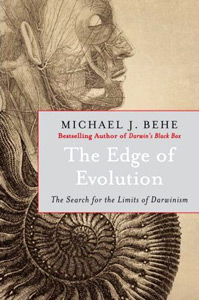 Behe explains that today's darwinian theory of evolution "is actually a mixture of several unrelated, entirely separate ideas. The three most important ideas to keep straight are random mutation, natural selection and common descent" (p 1). He observes, "...The power of random mutation and natural selection... has been grossly oversold to the modern public" (p 4). We agree.
Behe explains that today's darwinian theory of evolution "is actually a mixture of several unrelated, entirely separate ideas. The three most important ideas to keep straight are random mutation, natural selection and common descent" (p 1). He observes, "...The power of random mutation and natural selection... has been grossly oversold to the modern public" (p 4). We agree.
An example of something darwinian processes can do is the evolution of human resistance to malaria, which Behe discusses at length. The effective genetic changes are very few, mostly harmful, and not mathematically unlikely. But the same random mutation and selection process does not produce new features that require more than very few genetic changes. "...Mathematical probabilities and biochemical structures cannot support Darwinism's randomness, except at the margins of evolution," he writes (p 8). We agree.
An example of something that strictly darwinian processes cannot do, Behe believes, is the evolution of the bacterial flagellum, discussed fully in his earlier book. This lightning-rod example is not ignored by his critics. University of Chicago biologist Sean B. Carroll, in his new review, counters that such things are "well within [Darwinian evolution's] demonstrated powers." He supports this claim with a handful of references, the latest by two biochemists at the University of Arizona, published in April 2007. They write, "we could distinguish an ancient core set of 24 structural genes that were present in the common ancestor to all Bacteria. ...The relationships among these genes suggest the probable order in which the structural components of the bacterial flagellum arose." But from this reasonable, tentative inference, they leap immediately to a firm conclusion: "The core components of the bacterial flagellum originated through the successive duplication and modification of a few, or perhaps even a single, precursor gene." This leap is only publishable because they, their reviewers and their primary audience already believe that the conclusion (or something like it!) must be true. They exhibit what Behe describes as the "habit of forgetting the difference between what is assumed and what is demonstrated" (p 9).
But even if the Arizona team's conclusion were correct, it would not explain how the precursor gene acquired its flagellum-producing programming. Liu and Ochman suggest that it may have "originated as a primitive secretion system." Again, such speculation is published only because it supports the orthodoxy. Moreover, if we accept that speculation, are all of the subsequent mutational steps mathematically likely? The trouble is, if any genetic step looks too unlikely (>10 changed or inserted nucletides?), darwinists can simply say that viable intermediates must have existed, but the genetic-fossil record is incomplete. Of course. As our readers know, we think historical reconstructions based on today's genomes are a poor, third-best method for understanding the power of darwinian evolution. Closed-system demonstrations in biology (best), or computer models (next-best) are needed. So far, neither of these upholds the essential claims of the darwinists. Behe refers to the limited range of the biological ones in support of his thesis (p 141). But if he thinks computer models have any validity, he doesn't mention them.
Behe also notices that genetic programs often appear much older than the features they encode (p 193-194). To him this paradox for darwinism "is a tantalizing hint that the parts were moving into place over geological time for the subsequent purposeful, planned emergence of intelligent life." If he had left out the words purposeful, planned, we would still be in agreement with Behe. In fact, we could even live with those words, if the purpose and planning came from highly evolved prior life elsewhere in the universe. But this is not what Intelligent Design is about. The ID movement requires supernatural intervention (miracles) for the origin-of-life and the origins of the genetic programs for higher life forms. It does because, of course, there was a big bang. Interestingly, in the 2005 trial about the Dover PA public school science curriculum, Behe brought up the big bang so often that the judge finally begged to hear no more about it. At this point — miracles and the [standard, one-time-only] big bang — we, too, part ways with Behe.
Cosmic ancestry requires no miracles. It explains what we observe with natural causes and processes that can be demonstrated. It does not attempt to explain unobserved events like the origin of life or the origins of the genetic programs for higher life forms. The evidence for the big bang is not sufficient, in our opinion, to mandate these events. Also needed is real-time corroboration. Without that, one may logically doubt that the events (origins) ever happen. Of course, the darwinian theory also requires miracles, namely the overcoming of monstrous, endless unlikelihoods. Behe helps to expose this shortcoming. We wish darwinists would take Behe's valid points more seriously. Maybe we would all learn something. Meanwhile, in his new book, Behe comes a bit closer to our position. Godspeed, Michael!
 Michael J. Behe, The Edge of Evolution: The Search for the Limits of Darwinism, ISBN-10: 0743296206, [Free Press], 5 June 2007. Michael J. Behe, The Edge of Evolution: The Search for the Limits of Darwinism, ISBN-10: 0743296206, [Free Press], 5 June 2007.
 Michael J. Behe, The Edge of Evolution [First Chapter], published in The New York Times, 1 Jul 2007. Michael J. Behe, The Edge of Evolution [First Chapter], published in The New York Times, 1 Jul 2007.
 Sean B. Carroll, "God as Genetic Engineer" [review summary], 10.1126/science.1145104, p 1427-1428 v 316, Science, 8 Jun 2007. Sean B. Carroll, "God as Genetic Engineer" [review summary], 10.1126/science.1145104, p 1427-1428 v 316, Science, 8 Jun 2007.
 Renyi Liu and Howard Ochman, "Stepwise formation of the bacterial flagellar system" [abstract], 10.1073/pnas.0700266104, p 7116-7121 v 104, Proc. Natl. Acad. Sci. USA, 24 Apr 2007. Renyi Liu and Howard Ochman, "Stepwise formation of the bacterial flagellar system" [abstract], 10.1073/pnas.0700266104, p 7116-7121 v 104, Proc. Natl. Acad. Sci. USA, 24 Apr 2007.
 Kenneth R. Miller, "Falling over the edge" [review], 10.1038/4471055a, p 1055-1056 v 447, Nature, 28 Jun 2007. Kenneth R. Miller, "Falling over the edge" [review], 10.1038/4471055a, p 1055-1056 v 447, Nature, 28 Jun 2007.
 Jerry Coyne, "The Great Mutator" [text], The New Republic, online 20 Jun 2007. "This sequential way of getting twenty sixes.... is the way natural selection and mutation really work." Jerry Coyne, "The Great Mutator" [text], The New Republic, online 20 Jun 2007. "This sequential way of getting twenty sixes.... is the way natural selection and mutation really work."
 Richard Dawkins, "Inferior Design" [login], The New York Times, 1 Jul 2007. Dawkins ruefully announces Behe's final excommunication from science. Take heed, ye doubters! Richard Dawkins, "Inferior Design" [login], The New York Times, 1 Jul 2007. Dawkins ruefully announces Behe's final excommunication from science. Take heed, ye doubters!
 Evolution versus Creationism is a related CA webpage. Evolution versus Creationism is a related CA webpage.
 ...A Third Alternative is a related CA webpage. ...A Third Alternative is a related CA webpage.
 Testing Darwinism versus Cosmic Ancestry is a related CA webpage. Testing Darwinism versus Cosmic Ancestry is a related CA webpage.
 How Is It Possible? includes a mention of possible purpose or planning by highly evolved prior life elsewhere in the universe. How Is It Possible? includes a mention of possible purpose or planning by highly evolved prior life elsewhere in the universe.
 John Slorp's reply prompts our further comments about Dawkins' review, 2 Jul 2007. John Slorp's reply prompts our further comments about Dawkins' review, 2 Jul 2007.
 Michael Behe testified in favor of Intelligent Design in a lawsuit about the high school science curriculum in Dover, PA — What'sNEW, 19 Oct 2005. Michael Behe testified in favor of Intelligent Design in a lawsuit about the high school science curriculum in Dover, PA — What'sNEW, 19 Oct 2005.
 Thanks, Larry Klaes, for links to The New York Times. Thanks, Larry Klaes, for links to The New York Times.
 8 June 2007 8 June 2007
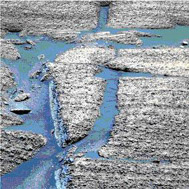 Liquid water on the surface of Mars?! A new analysis of pictures taken by the exploration rover Opportunity reveals what appear to be small ponds of liquid water on the surface of Mars. Ron Levin and Daniel Lyddy of Lockheed Martin used stereoscopic reconstruction to analyzed images from the Opportunity rover's twin cameras. They found bluish features that look perfectly flat. The surfaces are so smooth that the computer could not find any surface details within those areas to match up between the two images. The ...[flat] areas occupy the lowest parts of the terrain. They also appear transparent: some features, which Levin says may be submerged rocks or pebbles, can be seen below the plane of the smooth surface. The report was presented at a conference of the Institute of Electrical and Electronics Engineers. It is a highly controversial claim, as many scientists believe that liquid water cannot exist on the surface of Mars today because of the planet's thin atmosphere.
Liquid water on the surface of Mars?! A new analysis of pictures taken by the exploration rover Opportunity reveals what appear to be small ponds of liquid water on the surface of Mars. Ron Levin and Daniel Lyddy of Lockheed Martin used stereoscopic reconstruction to analyzed images from the Opportunity rover's twin cameras. They found bluish features that look perfectly flat. The surfaces are so smooth that the computer could not find any surface details within those areas to match up between the two images. The ...[flat] areas occupy the lowest parts of the terrain. They also appear transparent: some features, which Levin says may be submerged rocks or pebbles, can be seen below the plane of the smooth surface. The report was presented at a conference of the Institute of Electrical and Electronics Engineers. It is a highly controversial claim, as many scientists believe that liquid water cannot exist on the surface of Mars today because of the planet's thin atmosphere.
 Mars rover finds "puddles" on the planet's surface by David Chandler, NewScientist.com news service, 8 Jun 2007. Mars rover finds "puddles" on the planet's surface by David Chandler, NewScientist.com news service, 8 Jun 2007.
 Gilbert V. Levin, "Modern Myths Concerning Life on Mars" [text | Spanish text], Electroneurobiología, 30 Nov 2006. More evidence of liquid water, including more photos. Gilbert V. Levin, "Modern Myths Concerning Life on Mars" [text | Spanish text], Electroneurobiología, 30 Nov 2006. More evidence of liquid water, including more photos.
 Life on Mars!, the related CA webpage, has a special section, What'sNEW: Viking that lists new developments pertaining to work by Levin's father, Gil, who designed the Viking "Labeled Release" experiment. Life on Mars!, the related CA webpage, has a special section, What'sNEW: Viking that lists new developments pertaining to work by Levin's father, Gil, who designed the Viking "Labeled Release" experiment.
 Thanks, Jerry Chancellor. Thanks, Jerry Chancellor.
 2 June 2007 2 June 2007
The ignoring of data is, in fact, the easiest and most poular mode of obtaining unity in one's thought.
— William James, c. 1878. Cited (p 184) in  William James, by Robert D. Richardson, Houghton Mifflin Company, 2006. William James, by Robert D. Richardson, Houghton Mifflin Company, 2006.
 24 May 2007: The genetic and developmental toolkit.... an example of ignored data. 24 May 2007: The genetic and developmental toolkit.... an example of ignored data.
 1 June 2007 1 June 2007
Modern mammals, including humans, evolved not so much by inventing new genes, but by redeploying existing ones - with a surprising assist from genetic elements usually derided as mere junk.
 Opossum genome sequence reveals mammal secrets by Bob Holmes, NewScientist.com news service, 9 May 2007. Opossum genome sequence reveals mammal secrets by Bob Holmes, NewScientist.com news service, 9 May 2007.
 Viruses and Other Gene Transfer Mechanisms has lots about evolution by means other than point mutations [ Viruses and Other Gene Transfer Mechanisms has lots about evolution by means other than point mutations [ What'sNEW about HGT What'sNEW about HGT  ]. ].
 Thanks, Jerry Chancellor. Thanks, Jerry Chancellor.
 30 May 2007 30 May 2007
Superficially unrelated articles in Nature caught our attention. First, two reports and commentary explained a tidal-flexing mechanism that could be responsible for the "tiger-stripe" cracks on Saturn's moon Enceladus (right). The model best matches the observations when the moon's outer ice shell is mechanically decoupled from the rocky core. This decoupling is presumed to be due to an ocean of liquid water at depth, which makes the shell malleable enough to permit sufficient heating. So Enceladus, like several of Jupiter's moons, probably has an ice-covered ocean. Meanwhile, Nature's cover story announced the surprising abundance and variety of animal life that has just been seen on the deepest, darkest part of Earth's seafloor yet examined. An international team of marine biologists participating in the ANDEEP project, sampling as deep as 6,348 meters, saw 674 isopods species, of which 585 were new to science at the bottom the Weddell Sea and neighboring Antantarctic seas. They note that these seafloors may be periodically scoured by glacial-interglacial cycles of shelf ice advance and retreat. We wonder, could a deep dark seafloor on Enceladus also support abundant, various, exotic life? Or even just prokaryotic life?
 F. Nimmo et al., "Shear heating as the origin of the plumes and heat flux on Enceladus" [abstract], 10.1038/nature05783, p 289-291 v 447, Nature, 17 May 2007. F. Nimmo et al., "Shear heating as the origin of the plumes and heat flux on Enceladus" [abstract], 10.1038/nature05783, p 289-291 v 447, Nature, 17 May 2007.
 T. A. Hurford et al., "Eruptions arising from tidally controlled periodic openings of rifts on Enceladus" [abstract], 10.1038/nature05821, p 291-294 v 447, Nature, 17 May 2007. T. A. Hurford et al., "Eruptions arising from tidally controlled periodic openings of rifts on Enceladus" [abstract], 10.1038/nature05821, p 291-294 v 447, Nature, 17 May 2007.
 Andrew J. Dombard, "Cracks under stress" [text], 10.1038/447276a, p 276-277 v 447, Nature, 17 May 2007. Andrew J. Dombard, "Cracks under stress" [text], 10.1038/447276a, p 276-277 v 447, Nature, 17 May 2007.
 Angelika Brandt et al., "First insights into the biodiversity and biogeography of the Southern Ocean deep sea" [abstract], 10.1038/nature05827, p 307-311 v 447, Nature, 17 May 2007. Angelika Brandt et al., "First insights into the biodiversity and biogeography of the Southern Ocean deep sea" [abstract], 10.1038/nature05827, p 307-311 v 447, Nature, 17 May 2007.
 Wet Enceladus is a related What'sNEW article of 13 Mar 2006. Wet Enceladus is a related What'sNEW article of 13 Mar 2006.
 Life on Europa or Other Moons? has links to internal and external articles about possible life elsewhere. Life on Europa or Other Moons? has links to internal and external articles about possible life elsewhere.
 27 Mar 2008: Now NASA is asking, Could microbial life exist inside Enceladus? 27 Mar 2008: Now NASA is asking, Could microbial life exist inside Enceladus?
 29 May 2007 29 May 2007
 A Simpler Origin for Life is what New York University chemist Robert Shapiro claims to explain in Scientific American. The sudden appearance of a large self-copying molecule such as RNA was exceedingly improbable. Energy-driven networks of small molecules afford better odds as the initiators of life. The hardware aspect of the problem needed dumbing-down apparently. And as usual nowadays, the software aspect of the origin-of-life problem is barely mentioned. Is the solution at hand? Judge for yourself.
A Simpler Origin for Life is what New York University chemist Robert Shapiro claims to explain in Scientific American. The sudden appearance of a large self-copying molecule such as RNA was exceedingly improbable. Energy-driven networks of small molecules afford better odds as the initiators of life. The hardware aspect of the problem needed dumbing-down apparently. And as usual nowadays, the software aspect of the origin-of-life problem is barely mentioned. Is the solution at hand? Judge for yourself.
 Robert Shapiro, "A Simpler Origin for Life" [preview], p 46-53 v 296, Scientific American, June 2007. Robert Shapiro, "A Simpler Origin for Life" [preview], p 46-53 v 296, Scientific American, June 2007.
 The RNA World is the main CA webpage about origin-of-life theories. The RNA World is the main CA webpage about origin-of-life theories.
 24 May 2007 24 May 2007
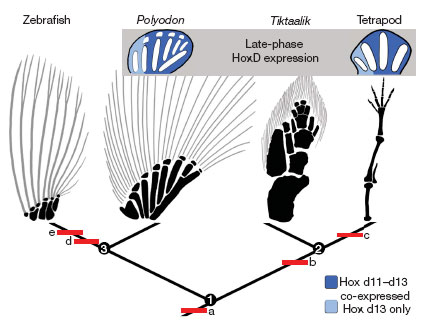 The genetic and developmental toolkit that builds limbs with fingers and toes was around long before the acquisition of limbs.
The genetic and developmental toolkit that builds limbs with fingers and toes was around long before the acquisition of limbs.
Biologists at The University of Chicago and the Field Museum of Natural History recently investigated the evolution of hands and feet — limb features present in many tetrapods and not in fish. According to darwinian logic, hands and feet must have begun to evolve in tetrapods only after they began trying to walk and grasp things. Of course this would be after the time when tetrapods parted ways with fish (after node 1) on the tree of life. Remarkably, the Chicago team found that a primitive paddlefish (Polydon spathula) has genetic programming nearly identical to that which produces hands and feet in tetrapods. According to standard darwinian theory, therefore, that genetic programming must have been present in a common ancestor before the evolutionary separation of tetrapods and fish (before node 1). This was long before there were hands and feet on Earth. According to darwinian logic, how does genetic programming get composed long before it can be affected by natural selection? [Lengthy silence.] But if life only descends as in cosmic ancestry, the proper genetic programming for any biological feature must be available prior to the emergence of the feature. The report from Chicago supports this axiom. The capability of building limbs with fingers and toes existed for a long period of time, but it took a set of environmental triggers to make use of that capability.
 Marcus C. Davis, Randall D. Dahn and Neil H. Shubin, "An autopodial-like pattern of Hox expression in the fins of a basal actinopterygian fish" [abstract | editor's summary], 10.1038/nature05838, p 473-476 v 447 Nature, 24 May 2007. Marcus C. Davis, Randall D. Dahn and Neil H. Shubin, "An autopodial-like pattern of Hox expression in the fins of a basal actinopterygian fish" [abstract | editor's summary], 10.1038/nature05838, p 473-476 v 447 Nature, 24 May 2007.
 New genetic data overturn long-held theory of limb development, The University of Chicago Medical Center, 24 May 2007. New genetic data overturn long-held theory of limb development, The University of Chicago Medical Center, 24 May 2007.
 Metazoan Genes Older Than Metazoa? is a related CA webpage. Metazoan Genes Older Than Metazoa? is a related CA webpage.
 Thanks, Newswise.com. Thanks, Newswise.com.
 23 May 2007 23 May 2007
...Ionizing radiation significantly enhances the growth of fungi that contain melanin.
Researchers at the Albert Einstein College of Medicine of Yeshiva University performed a variety of tests to measure the effect of radiation on fungi containing melanin. In one, two types of fungi were exposed to levels of ionizing radiation approximately 500 times higher than background levels. Both species grew significantly faster (as measured by the number of colony forming units and dry weight) than when exposed to standard background radiation. Apparently, the ability to thrive under intense radiation extends beyond the bacterial kingdom. Could fungi also carry life between planets?
 Researchers discover 'radiation-eating' fungi, Physorg.com, 23 May 2007. Researchers discover 'radiation-eating' fungi, Physorg.com, 23 May 2007.
 Zapped By Radiation, Fungi Flourish, by Michael Balter, ScienceNOW Daily News, 23 May 2007. Zapped By Radiation, Fungi Flourish, by Michael Balter, ScienceNOW Daily News, 23 May 2007.
 Hungry fungi chomp on radiation, doi:10.1038/news070521-5, by Heidi Ledford, News@Nature.com, 23 May 2007. Hungry fungi chomp on radiation, doi:10.1038/news070521-5, by Heidi Ledford, News@Nature.com, 23 May 2007.
 Major biological discovery…inside the Chernobyl reactor??, by Jason Minshull, WordPress.com, 27 May 2007. Major biological discovery…inside the Chernobyl reactor??, by Jason Minshull, WordPress.com, 27 May 2007.
 Bacteria: The Space Colonists considers the survival capabilities of bacteria. Fungi do not have a separate webpage. Maybe they need one. Bacteria: The Space Colonists considers the survival capabilities of bacteria. Fungi do not have a separate webpage. Maybe they need one.
 10 May 2007: E.O. Wilson mentions bacteria that can withstand intense radiation. 10 May 2007: E.O. Wilson mentions bacteria that can withstand intense radiation.
 Thanks, Sean Underwood and Justin Willingham. Thanks, Sean Underwood and Justin Willingham.
 16 May 2007 16 May 2007
...The focus has shifted towards analysing flows of gene populations, and even of entire prokaryotic genomes, into eukaryotes — James A. Lake, distinguished professor in the Departments of MCD Biology and Human Genetics, and in the Molecular Biology Institute, University of California, Los Angeles
 James A Lake, "Disappearing act" [text], 10.1038/446983a, p 983 v 446, Nature, 26 Apr 2007. James A Lake, "Disappearing act" [text], 10.1038/446983a, p 983 v 446, Nature, 26 Apr 2007.
 Viruses and Other Gene Transfer Mechanisms is a related CA webpage [ Viruses and Other Gene Transfer Mechanisms is a related CA webpage [ What'sNEW about HGT What'sNEW about HGT  ]. ].
 10 May 2007 10 May 2007
 E.O. Wilson thinks panspermia is likely: Some serious biologists – and I count myself among them – have begun to wonder that among the enormous and still unknown diversity of microorganisms one might – just might – find aliens among them – true aliens that arrived from outer space. They've had billions of years to do it. But especially during the earliest period of biological evolution on this planet. We do know that some bacterial species that have earthly origin are capable of almost unimaginable extremes of temperature and other harsh changes in environment, including hard radiation strong enough to crack the Pyrex vessels around the growing population of bacteria.
E.O. Wilson thinks panspermia is likely: Some serious biologists – and I count myself among them – have begun to wonder that among the enormous and still unknown diversity of microorganisms one might – just might – find aliens among them – true aliens that arrived from outer space. They've had billions of years to do it. But especially during the earliest period of biological evolution on this planet. We do know that some bacterial species that have earthly origin are capable of almost unimaginable extremes of temperature and other harsh changes in environment, including hard radiation strong enough to crack the Pyrex vessels around the growing population of bacteria.
Distinguished biologist E.O. Wilson spoke these words at the TED Conference in Monterrey CA, 7-10 Mar 2007. His theme was a plea for the preservation of our planet's biodiversity, which he believes to be in peril. We are thrilled that someone so distinguished has endorsed the possibility of panspermia as a source for life on Earth. And that's not all! To illustrate the diversity of life, Wilson noted that a ton of soil is expected to contain four million different species of bacteria, virtually all of them unknown. Then he observed, The variety of genes in viruses exceeds that in all of the rest of life combined. What are all those genes doing here? We have a suggestion.
 TED Prize wish: Help build the Encyclopedia of Life, talk by E.O. Wilson (Length: 22:35), 8 Mar 2007. TED Prize wish: Help build the Encyclopedia of Life, talk by E.O. Wilson (Length: 22:35), 8 Mar 2007.
 Wilson Life and Work, on the e.o.wilson biodiversity foundation website. Wilson Life and Work, on the e.o.wilson biodiversity foundation website.
 Introduction: More Than Panspermia is a related CA webpage. Introduction: More Than Panspermia is a related CA webpage.
 Bacteria: The Space Colonists is a related CA webpage. Bacteria: The Space Colonists is a related CA webpage.
 Viruses and Other Gene Transfer Mechanisms is the CA webpage elaborating on our suggestion [ Viruses and Other Gene Transfer Mechanisms is the CA webpage elaborating on our suggestion [ What'sNEW about HGT What'sNEW about HGT  ]. ].
 Thanks, Tom Ray. Thanks, Tom Ray.
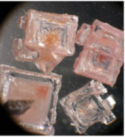
haloarchaea within tiny salt crystals |
 7 May 2007 7 May 2007
...Durability could enable haloarchaea to survive the period of deep-space travel between planets, perhaps encased in salt crystals.... — Shiladitya DasSarma
Many haloarchaea can withstand dessication, radiation, and very long periods of dormancy within salt crystals that also prevent contamination and provide some radiation shielding.
 Shiladitya DasSarma, "Extreme Microbes" [abstract], p 224-231 v 95, American Scientist, May-Jun 2007. Shiladitya DasSarma, "Extreme Microbes" [abstract], p 224-231 v 95, American Scientist, May-Jun 2007.
 Bacteria: The Space Colonists is the main related CA webpage. Bacteria: The Space Colonists is the main related CA webpage.
 Ancient Bacteria in Salt Crystals on Mars? is a related What'sNEW article, 9 Nov 2000. Ancient Bacteria in Salt Crystals on Mars? is a related What'sNEW article, 9 Nov 2000.
 250 Million-year-old bacteria have been revived is a related What'sNEW article, 19 Oct 2000. 250 Million-year-old bacteria have been revived is a related What'sNEW article, 19 Oct 2000.
 Salt in Zag meteorite... is a related What'sNEW article, 12 Jun 2000. Salt in Zag meteorite... is a related What'sNEW article, 12 Jun 2000.
|
 Behe explains that today's darwinian theory of evolution "is actually a mixture of several unrelated, entirely separate ideas. The three most important ideas to keep straight are random mutation, natural selection and common descent" (p 1). He observes, "...The power of random mutation and natural selection... has been grossly oversold to the modern public" (p 4). We agree.
Behe explains that today's darwinian theory of evolution "is actually a mixture of several unrelated, entirely separate ideas. The three most important ideas to keep straight are random mutation, natural selection and common descent" (p 1). He observes, "...The power of random mutation and natural selection... has been grossly oversold to the modern public" (p 4). We agree. Liquid water on the surface of Mars?! A new analysis of pictures taken by the exploration rover Opportunity reveals what appear to be small ponds of liquid water on the surface of Mars. Ron Levin and Daniel Lyddy of Lockheed Martin used stereoscopic reconstruction to analyzed images from the Opportunity rover's twin cameras. They found bluish features that look perfectly flat. The surfaces are so smooth that the computer could not find any surface details within those areas to match up between the two images. The ...[flat] areas occupy the lowest parts of the terrain. They also appear transparent: some features, which Levin says may be submerged rocks or pebbles, can be seen below the plane of the smooth surface. The report was presented at a conference of the Institute of Electrical and Electronics Engineers. It is a highly controversial claim, as many scientists believe that liquid water cannot exist on the surface of Mars today because of the planet's thin atmosphere.
Liquid water on the surface of Mars?! A new analysis of pictures taken by the exploration rover Opportunity reveals what appear to be small ponds of liquid water on the surface of Mars. Ron Levin and Daniel Lyddy of Lockheed Martin used stereoscopic reconstruction to analyzed images from the Opportunity rover's twin cameras. They found bluish features that look perfectly flat. The surfaces are so smooth that the computer could not find any surface details within those areas to match up between the two images. The ...[flat] areas occupy the lowest parts of the terrain. They also appear transparent: some features, which Levin says may be submerged rocks or pebbles, can be seen below the plane of the smooth surface. The report was presented at a conference of the Institute of Electrical and Electronics Engineers. It is a highly controversial claim, as many scientists believe that liquid water cannot exist on the surface of Mars today because of the planet's thin atmosphere.
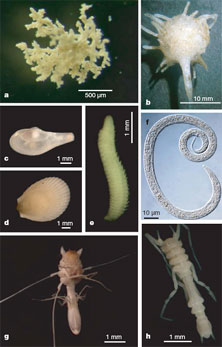
 A Simpler Origin for Life is what New York University chemist Robert Shapiro claims to explain in Scientific American. The sudden appearance of a large self-copying molecule such as RNA was exceedingly improbable. Energy-driven networks of small molecules afford better odds as the initiators of life. The hardware aspect of the problem needed dumbing-down apparently. And as usual nowadays, the software aspect of the origin-of-life problem is barely mentioned. Is the solution at hand? Judge for yourself.
A Simpler Origin for Life is what New York University chemist Robert Shapiro claims to explain in Scientific American. The sudden appearance of a large self-copying molecule such as RNA was exceedingly improbable. Energy-driven networks of small molecules afford better odds as the initiators of life. The hardware aspect of the problem needed dumbing-down apparently. And as usual nowadays, the software aspect of the origin-of-life problem is barely mentioned. Is the solution at hand? Judge for yourself. The genetic and developmental toolkit that builds limbs with fingers and toes was around long before the acquisition of limbs.
The genetic and developmental toolkit that builds limbs with fingers and toes was around long before the acquisition of limbs.
 E.O. Wilson thinks panspermia is likely: Some serious biologists – and I count myself among them – have begun to wonder that among the enormous and still unknown diversity of microorganisms one might – just might – find aliens among them – true aliens that arrived from outer space. They've had billions of years to do it. But especially during the earliest period of biological evolution on this planet. We do know that some bacterial species that have earthly origin are capable of almost unimaginable extremes of temperature and other harsh changes in environment, including hard radiation strong enough to crack the Pyrex vessels around the growing population of bacteria.
E.O. Wilson thinks panspermia is likely: Some serious biologists – and I count myself among them – have begun to wonder that among the enormous and still unknown diversity of microorganisms one might – just might – find aliens among them – true aliens that arrived from outer space. They've had billions of years to do it. But especially during the earliest period of biological evolution on this planet. We do know that some bacterial species that have earthly origin are capable of almost unimaginable extremes of temperature and other harsh changes in environment, including hard radiation strong enough to crack the Pyrex vessels around the growing population of bacteria.
